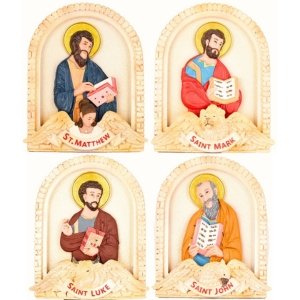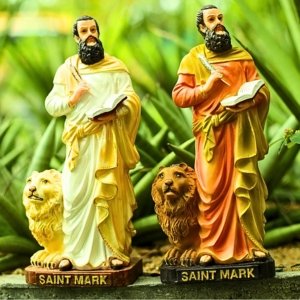The gospels are the first four books of the 27 books in the New Testament. The gospels are (far from exhaustive) narrative accounts of the life, death and resurrection of Jesus Christ. The Church has judged these accounts to have been produced through divine inspiration. The authors of these gospels, Matthew, Mark, Luke and John, are known as the Evangelists. Each evangelist wrote his gospel for a specific audience. Matthew wrote for the Jews, Mark for the Romans, Luke for the Greeks and John for the whole Christian world. In course of time, it became part of the Christian tradition to symbolically represent each Evangelist by a living creature, usually shown with wings.
 St. Matthew presents Jesus as King (Mt.28:18), then as Teacher (Mt.23:8) and then as Priest (Mt.26:64). Being a tax-collector under Roman occupation, he was, along with all his colleagues, considered a disgrace and a traitor to his own Jewish community. We could say that when Jesus called Matthew to be his disciple, the only things he retained from his old life were his pen and his record-keeping skills, a pre-figuring of his future role as an Evangelist. True to the maxim that grace perfects and does not destroy nature, Matthew shines in his retelling of those parables of Jesus which involve money, presenting the reader with fine distinctions in classes of financial dealings (e.g., tributes) and the various forms of currency used for legal tender in his time (e.g., talent, gold, silver). He also shows himself a keen chronicler, as seen by the fact that of the 1068 verses, in his gospel, three-fifths of them are words spoken directly by Jesus Himself. The phrase “that it might be fulfilled” appears ten times, and “which was spoken of” appears fourteen times, pointing to the pre-figuring of Jesus in the Jewish (Old Testament) scriptures, making it clear that the underlying and repeatedly emphasized thesis Matthew is anxious to present to his Jewish audience is: “Jesus is the promised messiah”. St Matthew is represented by an angelic man, a pointer to Jesus’ incarnation, which is meticulously outlined in this gospel.
St. Matthew presents Jesus as King (Mt.28:18), then as Teacher (Mt.23:8) and then as Priest (Mt.26:64). Being a tax-collector under Roman occupation, he was, along with all his colleagues, considered a disgrace and a traitor to his own Jewish community. We could say that when Jesus called Matthew to be his disciple, the only things he retained from his old life were his pen and his record-keeping skills, a pre-figuring of his future role as an Evangelist. True to the maxim that grace perfects and does not destroy nature, Matthew shines in his retelling of those parables of Jesus which involve money, presenting the reader with fine distinctions in classes of financial dealings (e.g., tributes) and the various forms of currency used for legal tender in his time (e.g., talent, gold, silver). He also shows himself a keen chronicler, as seen by the fact that of the 1068 verses, in his gospel, three-fifths of them are words spoken directly by Jesus Himself. The phrase “that it might be fulfilled” appears ten times, and “which was spoken of” appears fourteen times, pointing to the pre-figuring of Jesus in the Jewish (Old Testament) scriptures, making it clear that the underlying and repeatedly emphasized thesis Matthew is anxious to present to his Jewish audience is: “Jesus is the promised messiah”. St Matthew is represented by an angelic man, a pointer to Jesus’ incarnation, which is meticulously outlined in this gospel.
St. Mark wrote for the gentiles and for Roman readers in particular. His usage of Latin terms (census, centurion, denarius, legion, praetorium, pitcher etc.) makes this quite clear. He was a disciple and a spiritual son of St. Peter. He omits parables that would have immediately resonated with the Jews but would not have been expected to strike a chord when read by a Roman audience (e.g., the labourers in the vineyard, the prodigal son, the wedding garment). Further, there are no references to any prior prophecies or references to Old Testament; these would not have helped convince a Roman readership of his thesis. St. Mark’s gospel, the shortest of the four, is written in a vivid and energetic style (it would be an illuminating exercise to count the number of times the words “at once” appear in this gospel), which would have appealed to the Romans, a restless people who prioritised action over reflection. Jesus, in this gospel, gives the impression of being on a determined and forceful march towards his Passion, right from the beginning. Thus, St. Mark is fittingly symbolized by a winged lion, representing the power, majesty and vigour of the Word who has determined to enter into the sphere of creation.
St. Luke wrote his gospel before AD 67. He was born in Antioch, an important city in the Greek world and hence it is no surprise that he directs his work towards the Greeks. He is supposed to have been a doctor by profession. St. Paul calls Luke, “the beloved physician” – Col. 4:14. He uses unique terms very specific to the field of medicine (e.g., diagnosis, needle) and he is the only one who records the Virgin Birth (Luke 1:26-38). His gospel narrative places a significant emphasis on the instances of healings performed by Jesus, further strengthening the theory that he was a physician. St. Luke’s gospel places special emphasis on the priestly and sacrificial task of Jesus, which is heavily prefigured by the fact that this gospel begins with the narrative of the priest Zachariah, the father of St. John the Baptist. Thus, the ox, an animal used in sacrificial rituals, became the symbol of Luke. (Further, Christian tradition considers St. Luke to have been a capable artist; the famous Byzantine-style icon “Our Lady of Perpetual Succour” has been attributed to St. Luke by tradition.)
St. John wrote his gospel at the end of the first century. Due to this late authorship, he has the unique luxury of being able to address an audience that has already been Christian for some time now. The Church was well established by this time. He dives deep into the spiritual dimension of our Lord’s ministry. St. John is symbolized by an eagle, the lord of the skies, and is thus, in the classical mind, closest to the heavens of all living beings. This is fitting because of the spiritual heights to which the writings of St. John rise, both in his later apocalyptic visions and in the ecstatic and philosophical prologue of his Gospel. The Ven. Abp Fulton Sheen describes this gospel as an “…echo of a harp, whose perturbed strings were smitten by blood-stained hands and swept by the mighty winds of inspiration of the spirit into the greatest gospel that was ever written”
A night prayer that could be recited before retiring:
Matthew, Mark, Luke and John, Bless the bed that I lie on.
Before I lay me down to sleep, I give my soul to Christ to keep.
Four corners to my bed, Four angels there aspread,
Two to foot and two to head, And four to carry me when I’m dead.
I go by sea, I go by land; The Lord made me with His right hand.







Thank you for such a beautifully written and insightful blog on the Four Evangelists! I truly appreciate how you delved into the lives of Matthew, Mark, Luke, and John, highlighting their unique perspectives and contributions to the Gospels. Your explanations made their significance so much clearer, especially for someone like me who’s always wanted to understand the differences in their accounts. The historical and spiritual context you provided was incredibly enriching. This was a fascinating read and has deepened my appreciation for their role in the Christian faith. Keep up the inspiring work!
I must thank Ms Daphne Macleod and Venerable Archbishop Fulton Sheen for inspiring me through their preaching to write this piece. Very kind words. We must make it a point to read the gospels from time to time to brush up on our faith. More to come. Cheers!!
Very nicely written… Another expression of faith…
thanks a lot, dear Patrick. You purchased the 1st Evangelist from us!! that is one of our most unique and special products.
Very nice article. Keep it up!
Thank you dear Nestor!!
I fully agree with Staline C. Very informative.
Thanks Michael once again.
An amazing read… waiting for more to come.
Thanks a lot, dear Roseline!!! Watch out for this space. It will keep coming.
What a well written informative article about the four saints/evangelists who wrote the gospels. I really had no idea they were connected in the way you explained it. I’ve always enjoyed and learned from your insights into the holy. Your writings are clear and easy to comprehend. Looking forward to future articles .
thanks for your kind and generous words. Keep watching this space. Did you check out the article on Holy Communion? kindly do so